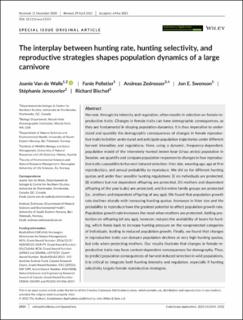| dc.contributor.author | Van de Walle, Joanie | |
| dc.contributor.author | Pelletier, Fanie | |
| dc.contributor.author | Zedrosser, Andreas | |
| dc.contributor.author | Swenson, Jon | |
| dc.contributor.author | Jenouvrier, Stéphanie | |
| dc.contributor.author | Bischof, Richard | |
| dc.date.accessioned | 2022-03-21T11:03:24Z | |
| dc.date.available | 2022-03-21T11:03:24Z | |
| dc.date.created | 2021-06-28T13:41:40Z | |
| dc.date.issued | 2021 | |
| dc.identifier.citation | Van de Walle, J., Pelletier, F., Zedrosser, A., Swenson, J. E., Jenouvrier, S. & Bischof, R. (2021). The interplay between hunting rate, hunting selectivity, and reproductive strategies shapes population dynamics of a large carnivore. Evolutionary Applications, 14(10), 2414-2432. | en_US |
| dc.identifier.issn | 1752-4571 | |
| dc.identifier.uri | https://hdl.handle.net/11250/2986414 | |
| dc.description.abstract | Harvest, through its intensity and regulation, often results in selection on female reproductive traits. Changes in female traits can have demographic consequences, as they are fundamental in shaping population dynamics. It is thus imperative to understand and quantify the demographic consequences of changes in female reproductive traits to better understand and anticipate population trajectories under different harvest intensities and regulations. Here, using a dynamic, frequency-dependent, population model of the intensively hunted brown bear (Ursus arctos) population in Sweden, we quantify and compare population responses to changes in four reproductive traits susceptible to harvest-induced selection: litter size, weaning age, age at first reproduction, and annual probability to reproduce. We did so for different hunting quotas and under four possible hunting regulations: (i) no individuals are protected, (ii) mothers but not dependent offspring are protected, (iii) mothers and dependent offspring of the year (cubs) are protected, and (iv) entire family groups are protected (i.e., mothers and dependent offspring of any age). We found that population growth rate declines sharply with increasing hunting quotas. Increases in litter size and the probability to reproduce have the greatest potential to affect population growth rate. Population growth rate increases the most when mothers are protected. Adding protection on offspring (of any age), however, reduces the availability of bears for hunting, which feeds back to increase hunting pressure on the nonprotected categories of individuals, leading to reduced population growth. Finally, we found that changes in reproductive traits can dampen population declines at very high hunting quotas, but only when protecting mothers. Our results illustrate that changes in female reproductive traits may have context-dependent consequences for demography. Thus, to predict population consequences of harvest-induced selection in wild populations, it is critical to integrate both hunting intensity and regulation, especially if hunting selectivity targets female reproductive strategies. | en_US |
| dc.language.iso | eng | en_US |
| dc.rights | Navngivelse 4.0 Internasjonal | * |
| dc.rights.uri | http://creativecommons.org/licenses/by/4.0/deed.no | * |
| dc.title | The interplay between hunting rate, hunting selectivity, and reproductive strategies shapes population dynamics of a large carnivore | en_US |
| dc.type | Peer reviewed | en_US |
| dc.type | Journal article | en_US |
| dc.description.version | publishedVersion | en_US |
| dc.rights.holder | © 2021 The Authors. | en_US |
| dc.source.pagenumber | 2414-2432 | en_US |
| dc.source.volume | 14 | en_US |
| dc.source.journal | Evolutionary Applications | en_US |
| dc.source.issue | 10 | en_US |
| dc.identifier.doi | https://doi.org/10.1111/eva.13253 | |
| dc.identifier.cristin | 1918936 | |
| dc.relation.project | Norges forskningsråd: 286886 | en_US |
| cristin.ispublished | true | |
| cristin.fulltext | original | |
| cristin.qualitycode | 2 | |

